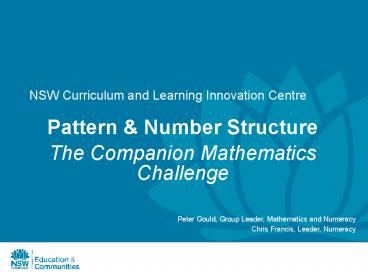NSW Curriculum and Learning Innovation Centre - PowerPoint PPT Presentation
1 / 18
Title:
NSW Curriculum and Learning Innovation Centre
Description:
Title: NSW Curriculum and Learning Innovation Centre Author: Head, Deanne Last modified by: Reviewer Document presentation format: On-screen Show (4:3) – PowerPoint PPT presentation
Number of Views:184
Avg rating:3.0/5.0
Title: NSW Curriculum and Learning Innovation Centre
1
NSW Curriculum and Learning Innovation Centre
- Pattern Number Structure
- The Companion Mathematics Challenge
Peter Gould, Group Leader, Mathematics and
Numeracy Chris Francis, Leader, Numeracy
2
A problem
Many of the questions students encounter in
day-to-day lessons do not provide a sense of what
it is like to engage in mathematical thinking.
Indeed, some students see mathematics as being
only about finding the correct answers to large
quantities of questions that are not particularly
challenging.
3
A problem
This lack of challenge has led to the
recommendation that greater emphasis be given to
providing students with frequent exposure to
higher-level mathematical problems rather than
routine procedural tasks, with increased
opportunities for students to discuss alternative
solutions and explain their thinking. (p. xii)
Australian National Numeracy Review Report (2008)
4
Finding problems
5
The mathematics challenges
The Mathematics Challenges aim to develop an
appreciation of
i. The design of mathematics problems that help
to develop mathematical reasoning. The problems
in both the Red dragonfly mathematics challenge
and the Companion mathematics challenge highlight
mathematical patterns, and the conditions under
which the patterns arise.
6
The mathematics challenges
ii. The value of specific methods of reasoning
in the problem solving process. These methods of
reasoning are part of mathematics and can
strengthen students mathematical dispositions to
investigate mathematical challenges.
7
The mathematics challenges
The Companion mathematics challenge provides a
range of problems carefully linked to the problem
types introduced in the Red dragonfly mathematics
challenge. Often the problems share the same
number in both books.
8
- From a problem to a lesson
9
Bug ate the calculation
mushi insect kui eat zan from Keisan
(calculation)
mushikuizan
10
Bug ate the calculation
- In a bug-ate-the-calculation problem blank
squares or cards stand in place of specific
digits. - This problem type can be applied to a range of
problems, such as subtracting a 2-digit number
from a 3-digit number.
11
Bug ate the calculation
In Stage 2 students use mental and written
strategies, including the formal written
algorithm, to solve addition and subtraction
problems involving numbers up to four digits.
NS2.2
12
Bug ate the calculation
3
What could the question have been?
Is there more than one answer?
13
Bug ate the calculation
5
What could the question have been?
Is there more than one answer?
How many answers are there?
14
Bug ate the calculation
How do you know?
2
What could the question have been?
Is there more than one answer?
How many answers are there?
15
Red dragonfly mathematics challenge
What number should be in each square? (1)
Replace the same letters with the same numbers to
make a correct sum. What do you get?
16
Companion mathematics challenge
Task
- Draft a lesson plan to support students
reasoning in solving the problem, What number
should be in each square? (1)
17
Developing students reasoning
- Reflecting on your own strategies and reasoning
to solve the problem - Ensuring all students understand the question
- Knowing how to begin the lesson
- Asking the right questions to promote logical
pathways for reasoning - Anticipating responses
- Moving student strategies beyond guess and
check - Managing differing ability levels
NSW Curriculum and Learning Innovation Centre
18
Bug ate the calculation
Choose digits (0 to 9) to complete the
calculation.
2
1
Multiply three-digit numbers by two-digit numbers
using the extended form (long multiplication)
NS3.3
x
3
7
4
8
6
0
3
4
4
4































